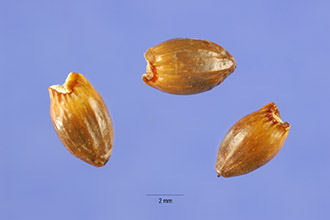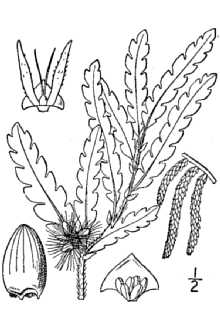Liquidambar peregrina L.
Scientific Name: Liquidambar peregrina L.

| General Information | |
|---|---|
| Usda Symbol | LIPE8 |
| Group | Dicot |
| Life Cycle | Perennial |
| Growth Habits | ShrubSubshrub, |
| Native Locations | LIPE8 |
Plant Guide
Use soil moisture sensors to measure the soil moisture of Liquidambar peregrina L..
Fact Sheet
Alternate Names
Comptonia peregrina (L,) Coult, var, aspleniifolia (L, Use soil moisture sensors to measure the soil moisture of Liquidambar peregrina L..,) Fern,, Myrica aspleniifolia L,, Myrica peregrina (L,) Kuntze
Uses
This nitrogen-fixing plant is used primarily as a ground cover for erosion control and species diversity in sterile, sandy soils. The abundant underground stems, or rhizomes, makes it especially suited to stabilizing steep, sandy banks. It makes a pleasing companion plant in a coastal setting with the low growing junipers, rugosa rose, bayberry, and beach plum.
Status
Please consult the PLANTS Web site and your State Department of Natural Resources for this plant’s current status (e.g. threatened or endangered species, state noxious status, and wetland indicator values). It is considered threatened or endangered in several states.
Description
Bayberry Family (Myricaceae). Sweetfern is a low, loosely branched, mat-forming shrub, 1-3 feet high, with sweet-scented, fern like leaves. The alternate, hair-covered leaves are 2-5 inches long and taper at each end. There is an occasional compound leaf form variation. The leaf blades are deeply cut into 20 or more rounded lobes, dark green above, paler and hair-covered beneath and on the midrib and margin above. Resinous glands cover both surfaces. Leaves are very aromatic when crushed. The flowers are small, inconspicuous catkins that bloom during April and May. Flowers of one or both sexes can be produced on an individual plant. The male catkins are rather long and cylindrical; the female catkins are short and rounded. In winter, the male catkins are prominent and erect. The female catkins become bur-like at maturity and are 1/2 inch in diameter. The seeds are nutlets that mature in August and become available in September and October. About four seeds are found in each fruit. Each seed is about 1/4 inch long, olive brown in color, and shiny.
Adaptation and Distribution
Distribution
Distribution
Sweetfern does especially well in open, sterile, sandy soils of woodlands, clearings, and pastures. It prefers acidic soils over limestone soils. USDA NRCS National Plant Materials Center Beltsville, MD Sweetfern is distributed throughout northeastern United States. For a current distribution map, please consult the Plant Profile page for this species on the PLANTS Website.
Establishment
Some nurseries offer wild collected clumps, but it is best established using nursery-grown, containerized plants. Losses of plants from the wild can be considerable. One or two year old liner material is also acceptable.
Plant Traits
Growth Requirements
| Temperature, Minimum (°F) | -38 |
|---|---|
| Adapted to Coarse Textured Soils | Yes |
| Adapted to Fine Textured Soils | No |
| Adapted to Medium Textured Soils | Yes |
| Anaerobic Tolerance | None |
| CaCO3 Tolerance | Low |
| Cold Stratification Required | Yes |
| Drought Tolerance | High |
| Fertility Requirement | Low |
| Fire Tolerance | High |
| Frost Free Days, Minimum | 100 |
| Hedge Tolerance | None |
| Moisture Use | Low |
| pH, Maximum | 7.0 |
| pH, Minimum | 4.0 |
| Planting Density per Acre, Maxim | 4800 |
| Planting Density per Acre, Minim | 1200 |
| Precipitation, Maximum | 60 |
| Precipitation, Minimum | 30 |
| Root Depth, Minimum (inches) | 14 |
| Salinity Tolerance | Low |
| Shade Tolerance | Intermediate |
Morphology/Physiology
| Bloat | None |
|---|---|
| Toxicity | None |
| Resprout Ability | Yes |
| Shape and Orientation | Erect |
| Active Growth Period | Summer |
| C:N Ratio | High |
| Coppice Potential | No |
| Fall Conspicuous | No |
| Fire Resistant | No |
| Flower Color | White |
| Flower Conspicuous | No |
| Foliage Color | Green |
| Foliage Porosity Summer | Moderate |
| Foliage Porosity Winter | Porous |
| Foliage Texture | Medium |
| Fruit/Seed Conspicuous | No |
| Nitrogen Fixation | Low |
| Low Growing Grass | No |
| Lifespan | Moderate |
| Leaf Retention | No |
| Known Allelopath | No |
| Height, Mature (feet) | 2.0 |
| Height at 20 Years, Maximum (fee | 2 |
| Growth Rate | Slow |
| Growth Form | Rhizomatous |
| Fruit/Seed Color | Brown |
Reproduction
| Vegetative Spread Rate | Moderate |
|---|---|
| Small Grain | No |
| Seedling Vigor | Low |
| Seed Spread Rate | None |
| Fruit/Seed Period End | Fall |
| Seed per Pound | 30000 |
| Propagated by Tubers | No |
| Propagated by Sprigs | No |
| Propagated by Sod | No |
| Propagated by Seed | No |
| Propagated by Corm | No |
| Propagated by Container | Yes |
| Propagated by Bulb | No |
| Propagated by Bare Root | Yes |
| Fruit/Seed Persistence | No |
| Fruit/Seed Period Begin | Summer |
| Fruit/Seed Abundance | Low |
| Commercial Availability | No Known Source |
| Bloom Period | Spring |
| Propagated by Cuttings | Yes |
Suitability/Use
| Veneer Product | No |
|---|---|
| Pulpwood Product | No |
| Protein Potential | Low |
| Post Product | No |
| Palatable Human | No |
| Palatable Graze Animal | Low |
| Palatable Browse Animal | Medium |
| Nursery Stock Product | No |
| Naval Store Product | No |
| Lumber Product | No |
| Fodder Product | No |
| Christmas Tree Product | No |
| Berry/Nut/Seed Product | No |

